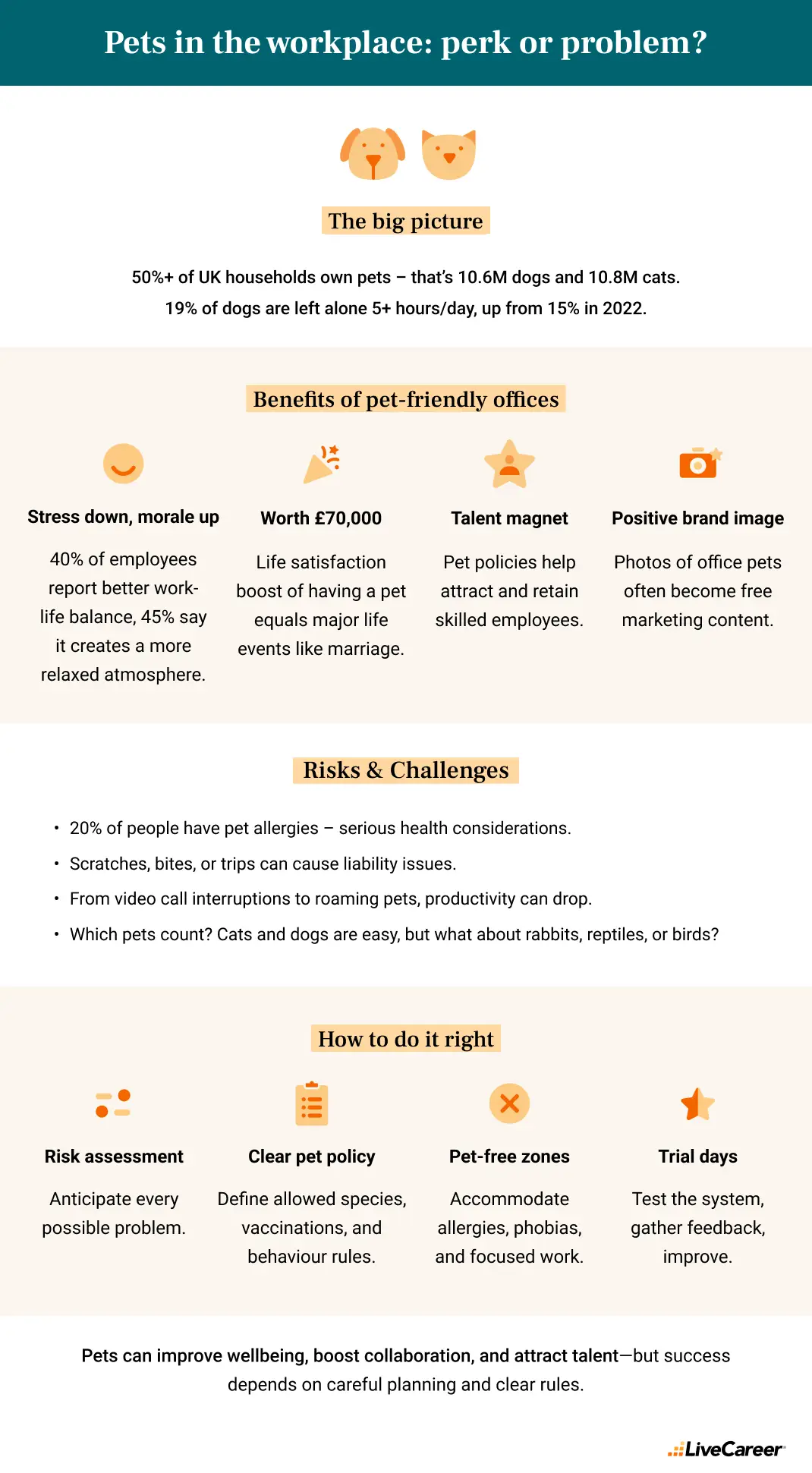
Under Pressure: European Workers Struggle (2025 Report)
In May 2025, we asked 1,000 European workers to share their concerns about the current economy—here’s a summary of the findings.
November 7, 2025
Last updated on 7 November, 2025

When over 50% of the UK population owns a pet, it’s not uncommon for employers to consider welcoming pets in the office. Enthusiasts of this idea argue that having pets in the workplace leads to a better work-life balance, increased satisfaction, and reduced stress. But what about liabilities?
As a proud cat owner (or rather, a human owned by a cat), I’ve decided to investigate this subject in detail to see if having pets in the workplace is a real perk or just a temporary trend.
Key insights:
Pet-friendly offices may seem like a post-pandemic trend, but in reality, businesses toyed with this idea even before COVID-19. Purina, one of the biggest pet food producers in the world, opened its offices for pets in 2003. The success encouraged Purina to take another step: launching a Pet at Work Alliance to help 200 European organisations become pet-friendly by 2020.
At Purina we believe that people and pets are better together – especially at work. From our own experience, we know that pet-friendly workplaces lead to a whole range of positive benefits such as higher employee engagement, talent retention, greater wellbeing, higher performance and productivity, increased inspiration and decreased stress.
The United Kingdom is a country of pet lovers, as evidenced by the number of animal companions. According to the PDSA Animal Wellbeing Report from 2024, there are approximately 10.6 million pet dogs and 10.8 million pet cats in Britain. A large proportion of the labour force cares for pets, as 28% of UK adults own a dog, and 24% own a cat.
While having pets has a positive effect on individual wellbeing, it also causes worries. The PDSA report mentions that 1 in 3 pet owners had to cut personal expenses to afford appropriate animal care, as the majority noticed that the cost of owning a pet has increased in recent years.
Animal lovers know well that pets need company. My cat is very outspoken against my leaving home, even for a few hours – he’s fortunate that I work from home. Sadly, many companies in the UK limit remote work possibilities, and pets are increasingly left alone at home: 19% of dogs must spend 5+ hours home alone each day (an increase from 15% in 2022). This worrying trend may force pet owners to quit and seek employment at companies that either allow remote work or offer pet-friendly workplace accommodations.
If you’re a business owner considering opening the company doors to pets, or an employee who wants to encourage your boss to allow pets at work, understanding the pros and cons of animal companions in the workplace can help.
Animals have a substantial positive impact on mental health. They help reduce loneliness, provide unconditional acceptance, and offer comfort. Research confirms this: in 2016, Purina collected feedback from European workers in pet-friendly workplaces. 40% of surveyed employees noticed that it enhanced their work-life balance. Additionally, 24% said having pets at work improved relationships in the workplace, and 45% said it created a more relaxed atmosphere. Plus, allowing domestic animals at work provides an opportunity to engage with cats and dogs for those employees who can’t have pets at home.
A recent study from the London School of Economics and University of Kent estimated that having a pet companion is worth up to £70,000 in terms of life satisfaction – comparable to satisfaction caused by significant life events, such as getting married, or spending time with friends and family regularly. It’s easy to imagine that having pets in the workplace would lead to similar benefits, as it would encourage employees to take regular breaks, go on short walks, and serve as talking points for colleagues. That could lead not only to a better atmosphere in the office but also to stronger collaboration.
Over a quarter of adults in Great Britain own pets. It’s a large portion of the labour force with valuable skills from all industries and sectors. Setting up a pet-friendly work environment could help attract candidates who would otherwise apply somewhere else, as well as help retain employees who don’t want to (or simply can’t) leave their pets at home unattended.
Opening the doors to pets can significantly improve brand image for any organisation. Employees will likely share stories about working alongside their beloved pets on social media, such as LinkedIn. Photos of animal-friendly amenities can serve as marketing material, and customer reviews mentioning cats and dogs might attract more clients.
Bringing pets to work can have a negative impact on workers’ physical and mental health. According to the Journal of Feline Medicine and Surgery, as much as 20% of the world population may have pet allergies, with symptoms ranging from mild to severe. Individual employees may suffer from animal-related phobias that could turn working in the presence of an adorable puppy into a nightmare. Additionally, pets that aren’t properly cared for may carry diseases or parasites that could spread to humans at work. These potential hazards to workers’ health must be anticipated and accounted for before allowing any employees to bring their beloved companions into the workplace.
When thinking of pets, we usually imagine cats and dogs. But these aren’t the only companion animals people keep, as popular choices also include fish, rabbits, horses, reptiles, rodents, and birds. A policy allowing pets in the workplace would need to define which pets are allowed. Opening the doors solely to cats and dogs could lead to resentment among employees who own a different type of pet; on the other hand, it’s difficult to imagine bringing a pony or a caiman to the office.
Working in the presence of my cat has taught me that it’s impossible to plan my work day in detail. He’s known to interrupt video calls, lie on the keyboard, and loudly demand treats when I’m trying to focus. I can easily imagine how distracting pets could be in any office, especially if a few of them roam around freely. To ensure everyone can complete their duties, the workplace should organise pet-free spaces for deep focus, as well as designate one (or several) employees responsible for ensuring the animals don’t disturb peace too much.
While there are currently no official regulations regarding pets in the workplace, employers are required by law to ensure the health and safety of all workers, as well as visitors to their premises. Having pets at work could make that difficult: accidental scratches, bites, or tripping over pets would become a part of daily life. If you work at an organisation catering to children or vulnerable persons, consult insurance companies to find the best liability protection.
Pets don’t always get along with each other, and they aren’t fond of strangers. A new environment can make them curious, but may also scare them. Pets could end up getting lost, escaping the workplace on their own, or getting into fights with one another. Additionally, not all workplaces can be adjusted to pets’ needs. Before opening its doors to animal companions, any business must ensure that its environmentis pet-proof, with nohard-to-access crawlspaces where pets could hide, no sharp tools or other dangerousobjects in the vicinity, and no food items toxic to pets.
Preparing the workplace to welcome pets requires extra investments. Consulting animal care and HR experts to outline the policy, arranging a pet-friendly office space, and getting litter boxes are the minimum.
If you’re a pet owner or a CEO who wants to introduce a pet-friendly company policy, good preparation is the first step you must take. Take a good look at your work environment and imagine animal companions roaming around it. This simple visualisation exercise can help you anticipate problems and start thinking about required solutions. The tips below are a good starting point:
Start by imagining everything that could go wrong. Employees scratched by cats, dogs tearing apart archival documents, hamsters lost in the staff kitchen – all of it can happen if the workplace isn’t prepared. Even the slightest possibility of risk must be anticipated. Making a detailed risk assessment with the HR team can help formulate an action plan that includes necessary adjustments before allowing pets into the workplace. Consider consulting animal welfare organisations for assistance.
Welcoming animal companions in the workplace requires setting up strict guidelines and regulations beforehand. At a minimum, you must define which pets are allowed; otherwise, your company may end up invaded with tarantulas and bearded dragons. All animals should have required vaccinations, be healthy and well-groomed, obedient and well-socialised, microchipped (if possible), and covered under an owner’s policy. Plan how many pets could be accommodated on a given day, and how to proceed in case of behavioural problems or emergencies.
Some employees may not be happy with having pets around them – they may have phobias or allergies, consider animals unsanitary, or simply prefer to focus on work tasks in peace. That’s why pets should be allowed only in specific areas and kept away from other spaces such as kitchens, conference rooms, workshops, etc.
When you feel that the workplace has been pet-proofed and all policies have been outlined, organise a trial day. Inform everyone in advance and provide training for all employees to ensure everyone knows how to interact with pets safely. After the training, allow select employees to bring their pets along for a few hours and observe how everything goes. After the trial day, collect anonymous feedback to learn what your colleagues think about this experience. Be open to their suggestions to see if anything can be improved.

Allowing pets in the workplace can be a hit among employees or a nightmare fodder, depending on preparation. Personally, I’d love to have more four-legged friends around me at all times; however, I can imagine this would significantly reduce my productivity at work, as my lovely cat constantly reminds me who’s the boss.
To reap the benefits of animal companionship, your workplace must have guidelines for both pet owners and all staff members who may interact with animals. The safety of people and pets is your priority. A secure work environment, prepared staff, and well-behaved pets can contribute to better work-life balance and an excellent PR for your organisation.
This article on pets in the 2025 workplace was written based on a multi-source review of credible reports and animal welfare guidelines. The process included:
This methodology ensures that the insights featured in this article can help both pet-owning workers and business owners decide whether to welcome pets in their workplaces.
Our editorial team has reviewed this article for compliance with LiveCareer’s editorial guidelines. It’s to ensure that our expert advice and recommendations are consistent across all our career guides and align with current CV and cover letter writing standards and trends. We’re trusted by over 10 million job seekers, supporting them on their way to finding their dream job. Each article is preceded by research and scrutiny to ensure our content responds to current market trends and demand.
Category: Career Advice
Crafting a job-winning CV is all about showcasing your unique skills and experiences. Start with a strong personal statement that highlights your career goals and achievements.
Try Our CV Builder Now